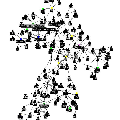Combining symbolic and geometric reasoning in multi-agent systems is a challenging task that involves planning, scheduling, and synchronization problems. Existing works overlooked the variability of task duration and geometric feasibility that is intrinsic to these systems because of the interaction between agents and the environment. We propose a combined task and motion planning approach to optimize sequencing, assignment, and execution of tasks under temporal and spatial variability. The framework relies on decoupling tasks and actions, where an action is one possible geometric realization of a symbolic task. At the task level, timeline-based planning deals with temporal constraints, duration variability, and synergic assignment of tasks. At the action level, online motion planning plans for the actual movements dealing with environmental changes. We demonstrate the approach effectiveness in a collaborative manufacturing scenario, in which a robotic arm and a human worker shall assemble a mosaic in the shortest time possible. Compared with existing works, our approach applies to a broader range of applications and reduces the execution time of the process.
翻译:将符号推理与几何推理结合在多智能体系统中是一个具有挑战性的任务,涉及计划、调度和同步问题。现有的工作忽略了任务持续时间和几何可行性的变异性,这是由于智能体和环境之间的交互所固有的。因此我们提出了一种联合任务和运动规划方法,以优化任务的排序、分配和执行的时空变异问题。该框架依靠任务和操作的解耦,其中操作是符号任务的一个可能的几何实现。在任务层面上,基于时间轴的规划处理时间约束,持续时间变异和任务的协同分配。在动作层面上,在线运动规划规划实际的移动,处理环境变化。我们在一个协作制造场景中展示了方法的实效性,在该场景中,一个机器人手臂和一个人工工人需尽可能快地组装马赛克。与现有的工作相比,我们的方法适用范围更广,能够减少过程的执行时间。


